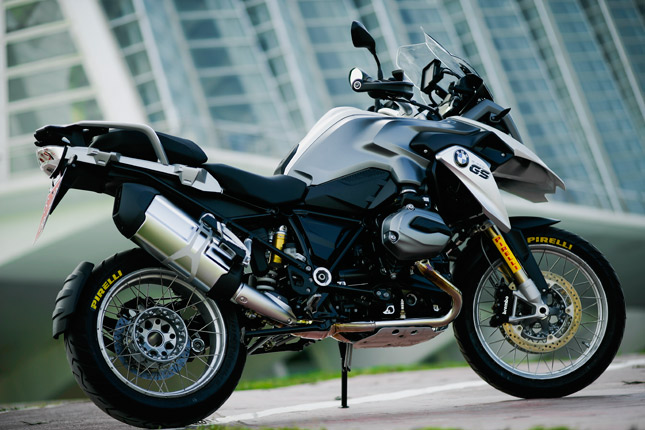 One thing that is common for athletes throughout all disciplines is that they make sure they have the perfect pair of shoes, best suited to their sport, and themselves, before they head out into the field. This tells us how important it is to know our shoes and have the perfect pair on. Tyres are the shoes for our bikes and before we take our rides out into the field it is absolutely necessary for us to know everything about tyres so that we can make sure we have the perfect pair on.
One thing that is common for athletes throughout all disciplines is that they make sure they have the perfect pair of shoes, best suited to their sport, and themselves, before they head out into the field. This tells us how important it is to know our shoes and have the perfect pair on. Tyres are the shoes for our bikes and before we take our rides out into the field it is absolutely necessary for us to know everything about tyres so that we can make sure we have the perfect pair on. Tyres are more than just rubber donuts with artistic dressing. A lot of research and development in a vast number of different sciences goes into manufacturing a tyre. Tyres are an epitome of mankind’s engineering prowess. So let’s understand bike shoes!
How is tyre size specified?
Just like shoes, tyres don’t come as one size fits all. Before swapping the tyres on our bike we must make sure we get the right size. You might be familiar with markings similar to these on a tyre- 130/60 R 15
RELATED ARTICLE: All You Need To Know About Your Motorcycle Tyre
Here, the first number (130) defines the width of the tyre in millimetres. The second number (60) is the height of the wheel sidewall as percentage of the wheel width. This percentage is called the aspect ratio of the tyre. R signifies that this is a radial ply tyre (other type is bias ply, more on that later). The last number (15) is the wheel rim diameter in inches.
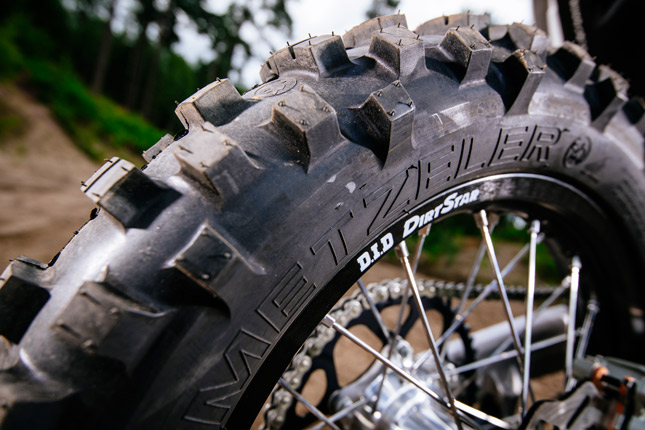 What is Aspect Ratio?
What is Aspect Ratio?Aspect ratios can tell a lot about the handling characteristics of a tyre. A high aspect ratio (60-70) means a tyre with a high sidewall. Tyres with a high aspect ratio can absorb shocks pretty well. This makes them an ideal choice for off-roading or for those who often travel on poor roads. But a high sidewall also means a greater side thrust while cornering; resulting in slip angles quickly reaching their limiting value and thus a sub-par handling performance.
Tyres with smaller aspect ratios are very good for cornering as they have a smaller sidewall and thus less side thrust. This is the reason why sports cars have very thin tyres (some can have aspect ratios as small as 30). However, as you might have already guessed, these tyres do not handle shocks well and can give a hard ride. There is always a bargain between the handling and shock absorbing capabilities of a tyre and aspect ratio expresses what a particular tyre is good at.
Should the tyres be filled with Nitrogen?
Fun fact: Air contains 78% nitrogen. This means, the regular pressurized air filled in our tyres is already 78% nitrogen. So why strive for the extra 22%. There are two reasons for that and unless you are a professional track racer, performance is not one of them. The first reason is that oxygen is more prone to escape the tyres through the walls and thus the pressure in the tyres gets lower over time. Nitrogen is comparatively less prone to escape through the tyre walls and hence it means having stable tyre pressure for longer periods.
RELATED ARTICLE: Nitrogen Vs Regular Compressed Air- The Duel For Your Motorcycle Tires
The second reason is that when tyres are filed with pure nitrogen we also get rid of the atmospheric moisture that would enter into our tyres with the regular air. Under the high tyre pressures, moisture gets converted into water upon even a slight change in temperature. This varies the tyre pressure largely with temperature. Also, if the rims are made of cast iron or steel, they tend to corrode by this water.
If you’re a professional track racer and to you even a half psi change in tyre pressure means significant change in track times, then, and only then, does having nitrogen in your tyres means a better performance as nitrogen means more stable pressure when the tyres progressively heat up during the race.
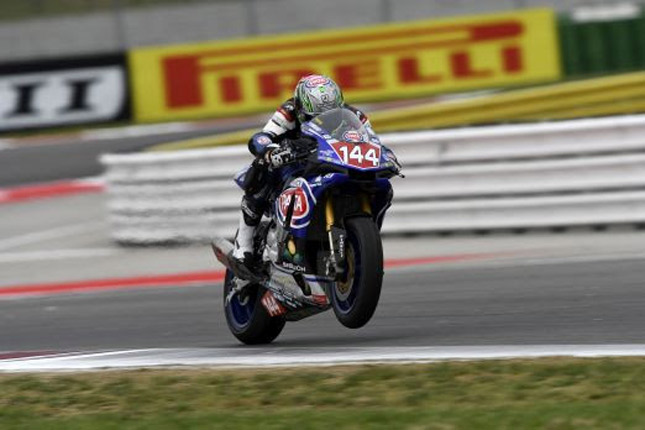 What is the effect of temperature on tyres?
What is the effect of temperature on tyres?We often get to hear professional riders talking about heating up their tyres before hitting the track. What does that mean? How does heating the tyres make a difference?
Well here’s the deal. Tyres are made of vulcanized rubber. As the temperature increases the rubber gets softer and stickier due to certain inherent chemical traits. This means we get a superior road grip from the tyres as their temperature increases. Pulling off a burnout before riding isn’t such a bad idea after all.
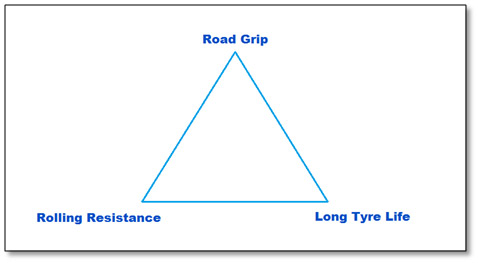 What is the performance triangle?
What is the performance triangle?The behavior of a tyre on the road is usually a trade-off between three points. These points can be imagined as three vertices of a triangle and as we get closer to one trait we lose out on the others.
• Road Grip: A better road grip inspires more confidence. It means better handling through corners and shorter braking distance. In other words, more road grip means more fun. Tyres with softer rubber give better road grip than the hard ones.
• Rolling Resistance: This is the resistance that the tyres offer to the forward motion of the bike. High rolling resistance means better contact between the road and the tyres, but it also means lower fuel efficiency. An optimum balance has to be reached in this case.
• Tyre Life: Tyres with soft rubber tend to wear out quickly. Tyres with hard rubber last long. There is always a trade-off between the life of tyre and the performance we expect from them.
A good example would be the Metzelers offered on the KTM Duke 390 and RC 390. These tyres are very soft and offer great grip but wear out in a mere 15,000 kms.
• Rolling Resistance: This is the resistance that the tyres offer to the forward motion of the bike. High rolling resistance means better contact between the road and the tyres, but it also means lower fuel efficiency. An optimum balance has to be reached in this case.
• Tyre Life: Tyres with soft rubber tend to wear out quickly. Tyres with hard rubber last long. There is always a trade-off between the life of tyre and the performance we expect from them.
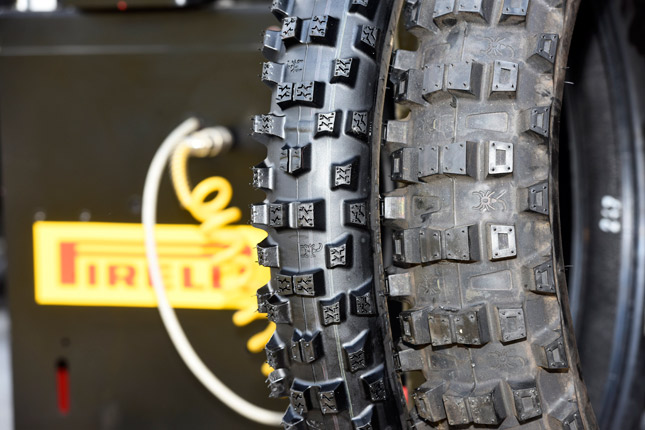 What is the difference between track tyres and road tyres?
What is the difference between track tyres and road tyres?Track tyres are made from special rubber compounds with the only intention of having best track performance. These tyres offer very good grip inspiring a lot of confidence, better cornering performance due to high limiting slip angles, and above all, the best stopping distances resulting in great track times. However, contrary to popular belief, these tyres are useless on the street. Mainly for the following reasons –
• Track tyres are designed to operate at the high temperatures reached during racing due to the aggressive acceleration and braking. Riding on street is totally different. No matter how aggressively we ride, tyres seldom heat up to the temperatures they do on track and hence we can’t get the best out of track tyres on the street. In fact at insufficient temperatures, track tyres work poorer than regular street tyres.
READ ALSO: Tyre Compounds- All You Need To Know
• Tyres have this trade-off between wet grip and dry grip. The tread patterns on tyres are intended to deflect water on wet roads so that the rubber makes maximum contact with the tarmac. This however works counter productively for grip on dry roads as the rubber contact with tarmac reduces due to these same tread patterns. Track tyres are manufactured with high emphasis on grip and as a result separate tyres are manufactured for dry and wet conditions. If we use track tyres, we cannot swap them every time the sky is overcast, can we?
READ ALSO: Tyre Compounds- All You Need To Know
• Tyres have this trade-off between wet grip and dry grip. The tread patterns on tyres are intended to deflect water on wet roads so that the rubber makes maximum contact with the tarmac. This however works counter productively for grip on dry roads as the rubber contact with tarmac reduces due to these same tread patterns. Track tyres are manufactured with high emphasis on grip and as a result separate tyres are manufactured for dry and wet conditions. If we use track tyres, we cannot swap them every time the sky is overcast, can we?
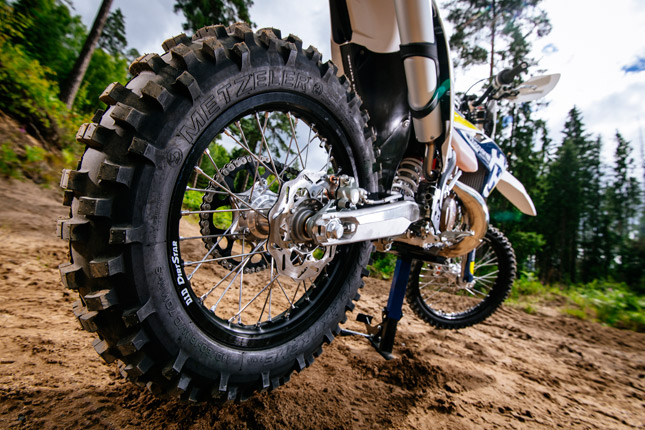 What’s the argument about tyres with tubes v/s tubeless tyres?
What’s the argument about tyres with tubes v/s tubeless tyres?Tubeless tyres are the new talk of the town with every manufacturer opting tubeless tyres for their newer models and thus slowly phasing out the tyres with tubes. There have been many theories out there as to why tubeless tyres shall be preferred over tyres with tubes, ranging from tubeless tyres yielding better fuel efficiency to offering better performance and as any technically sound person would tell you, most of them are BS.
RELATED ARTICLE: Motorcycle Tube Tyres Vs Tubeless Tyres
The most practical difference between these tyres at the user end is how a puncture is repaired. No, I’m not kidding. Tubeless tyres can be repaired easily and in minutes without the need of detaching the entire wheel from the bike. Earlier, not all roadside puncture mending shops offered to repair these tyres, but now every one of them repairs punctures on tubeless tyres. Tyres with tubes on the other hand take a lot of time to be mended and involve a lot of labour as the entire wheel has to be detached from the bike. However repairing punctures on tubeless tyres still remains cheaper and this baffles me.
Tubeless tyres also weigh less as there is no tube involved and thus we save around a kilogram on both the wheels. This may not seem a lot in terms of absolute weight but we should keep in mind that this is the inertial weight we are saving and it is a considerable fact dynamically speaking.
RELATED ARTICLE: Fixing Your Tubeless Tyres Made Easy
When tyres with tubes are run on low pressure the tube can be damage due to pinching when we encounter a bump along the way. These pinch flats are also notorious of damaging the valve and thus rendering the whole tube useless. Pinch flats do not occur on tubeless tyres and hence they can be run on much lower tyre pressures without any damage. In tyres with tube, in case of a puncture there are high chances of damaging the valve since it is mounted on the tube rather than on the wheel. This, as mentioned earlier, renders the entire tube useless. There are no such risks involved with tubeless tyres.
Also, in case of a puncture, tyres with tube lose air rapidly and leave us with no option but to push our bike if you don’t want to damage the tube. Tubeless tyres on the other hand lose air gradually when punctured. This means we can ride the bike slowly to a repair shop without damaging anything.
So yes, tubeless tyres shall be preferred, but only for these practical reasons. Now my friend, you know your bike shoes well. Hope you get the best pair next time you launch yourself on a shopping spree.
By: Nehal Chaliawala











